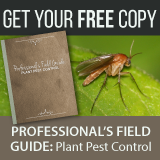

Pages: 1
| Posted: 05 Sep 2013 23:54 | |
|
Registered User Currently Offline Join Date: Feb 2012 |
Posts: 45 Reputation: Unranked User Rank: 1 - Seedling 
|
|
So all of a sudden I have gotten mealy at two locations. One is on 14" bird of paradise and the other is on 17" Marginata's. I have wiped them and sprayed them with incsecticidal soap. At a previous place I used to work we used Merit granules to help treat them. does anyone know the recommended dosage for this? Also, any other recommendations? As you know it's tough to clean those little critters out of all the little crevices of the marg and in the new spikes of the birds.
I would love your input! Thanks! |
|
| Posted: 06 Sep 2013 01:02 Last Edited By: Ninjafinch | |
|
Registered User Currently Offline Join Date: Jun 2013 |
Posts: 1 Reputation: Unranked User Rank: 1 - Seedling 
|
|
I had an account with 10-15 bird of paradise plants in it, among other plants and accounts that had mealy bug. Looked like cotton candy. I had to clean these up when I took the accounts over, and I used Foliage Wonder, which is a leaf shine. First off, it shines up the leaves and beautifies the plant! But it also suffocates mealy bugs and I've used it on spider mites and other pests too. It works WONDERS! I've completely eradicated the mealy after diligently applying to every part of the plant (under the leaves, stems, and so on) for about 4-8 weeks (sometimes less.) I did have a side effect when using on pothos, though. It almost killed and rotted entire plants (just a few) and made the stems/leaves icky and gooey and smelly. So be careful. Better than mealy bugs though. I put about 2 cap fulls into a spray bottle (give or take, shake well!) and spray the heck out of the plant. It works miracles. I believe it is silicone based, just in case anyone is allergic. Anyway.... I'll stop rambling. Oh, and it smells nice.
Edit: I don't use merit, or anything of that sort. They become resistant and it simply has never worked for me. One last thing, the mealy bugs do not seem to like the leaves that are already covered in Foliage wonder. And... Spraying new unopened leaves can be obnoxious too. You'll figure it out.. |
|
| Posted: 06 Sep 2013 15:02 | |
|
Registered User Currently Offline Join Date: Jan 2011 |
Posts: 798 Reputation: 43 User Rank: 10 - Blossom 
|
|
Foliage Wonder is a leafshine product, and is not labeled for treating insect infestations, so if you intentionally do that you are technically (which means "actually") in violation of the product label and federal and state pesticide laws. But then you probably already knew that. Sure, you'll say that you used the product for its intended purpose as a leafshine/cleaner, and the pests just happened to be controlled in the process, sort of a "side-benefit". That would be disingenuous, though (some people might call it "lying", but we won't judge).
Controlling mealybugs can be easy or difficult, depending on the plant material, type of mealybug, and your choice of control measures. It's much easier and more efficient to treat an infested plant at your facility, replacing it temporarily or permanently with a clean plant while you "nurse" the infested one back to health. That limits the potential spread of the infestation from Patient Zero to other plants on the account. And since mealybugs will hide inside and under containers, in carpeting, draperies and partition fabrics, the sooner the source of the infestation is removed from the account, the less trouble for you. As for choices of treatments, if you do go the pesticide route, be sure you're in compliance with all of your state and federal laws and regs, be properly licensed, insured, etc. And don't use over-the-counter retail formulations, which typically have a much lower dose of active ingredients than commercial products. Be sure to rotate chemistries. That means don't use the same product or class of products more than twice in a row on a crop or plant. The chemistry class is indicated in a box on the product label. So, for instance, don't use two neonicotinoids in succession on the same plant; this will avoid or forestall pest resistance to that chemistry and will give better control of the pest for you. If you choose to use "alternative" products or biocontrols, be aware that most of these don't work well on established, heavy infestations of most pests. They can knock down and control an infestation that is fairly small and new, but you're knocking your head against a brick wall if you introduce predator/parasite controls on a raging infestation of mites or scale or mealybug. |
|
| Posted: 18 Apr 2014 21:07 Last Edited By: Melanie | |
|
Registered User Currently Offline Join Date: May 2012 |
Posts: 11 Reputation: 1 User Rank: 1 - Seedling 
|
|
You might want to check out our brand new Professional's Field Guide to plant pest control authored by Suzanne Wainwright-Evans aka The Buglady
-Proper Identification -Life Cycle -Clear Indicators of an Infestation -Management and Prevention http://guides.newprocontainers.com/profession ... |
|
| Posted: 07 Aug 2014 09:54 | |
|
Registered User Currently Offline Join Date: Aug 2014 |
Posts: 8 Reputation: Unranked User Rank: 1 - Seedling 
|
|
consistency and repetition is the key, there is no magic pesticide bullet
and no one time wonders. use a low impact product like soap and water and over time you'll gain control. acceptance is another key, they will always be there!!! your service intervals will play a part as well, weekly service no prob, bi weekly or monthly, replace the plant or make arrangements for additional treatments errr cleanings…. gl |
|
| Posted: 07 Aug 2014 21:18 | |
|
Registered User Currently Offline Join Date: Jan 2011 |
Posts: 798 Reputation: 43 User Rank: 10 - Blossom 
|
|
We have found that sourcing is the key. We had consistent problems with one nursery's Pothos for awhile...they would arrive with vigorously moving mealybugs on them right off the trailer. If we have to spend time and money treating plants that should have been treated regularly during the production cycle by the grower, then (a) we're unhappy and (b) we're going to take a credit against that invoice for the time and materials we use to do their job for them after the fact. It's just business...nothing personal.
That said, scouting is important, as is commuicating with clients about refraining from bringing plants from outside sources onto the account without consulting us. We need to be sure they're not bringing "Typhoid Marys" into a clean interiorscape that we will have to deal with later at our expense. Many times it's easier to replace and treat the infestation at our nursery than do it on site. That's a cost of doing this business. |
|
| Posted: 30 Nov 2014 04:55 | |
|
Registered User Currently Offline Join Date: Jun 2012 |
Posts: 39 Reputation: 3 User Rank: 1 - Seedling 
|
| Just reading back over the thread, I wanted to say something about Ricky's comment on "acceptance" of mealy bugs. I'm sure he meant accept that they'll always be around and you need to constantly be on guard for them. If you accept them without trying to control them, you soon end up with plants that look like they're full of Christmas flocking. | |
| Posted: 01 Dec 2014 00:15 | |
|
Registered User Currently Offline Join Date: Jan 2011 |
Posts: 798 Reputation: 43 User Rank: 10 - Blossom 
|
| If you offer your services as a professional interior plant maintenance contractor, then you are obliged to commit to SOME KIND OF PLAN for controlling pests and diseases. IPM (Integrated Pest Management) is a rational, common-sense plan to deal with whatever pest challenges arise, whether they be in a greenhouse, nursery field, garden center or interiorscape. IPM involves an arsenal of techniques and strategies, including scouting, hand-picking, pesticides, non-pesticidal controls (biocontrols, predators, parasites, etc.), management of fertilization and environmental factors, proper plant selection for the conditions, etc. No one tool will work to control or prevent every pest or disease problem, so you have to be well-schooled in the life cycles and behaviors of the organisms you will be dealing with. There are no "magic bullets" per se, but there are methods that give quicker, more complete results and can interrupt pest life cycles to prevent re-infestation better than other methods. Learn everything you can about the subject from people who have a lot of experience dealing with pests and pathogens in the interiorscape, because it's a different world from the other, more traditional venues in the green industry, with its own ground rules and challenges. | |
Pages: 1
Interiorscape.com is sponsored by NewPro Containers ![]() RSS 2.0
RSS 2.0 ![]() Atom 1.0
Atom 1.0













